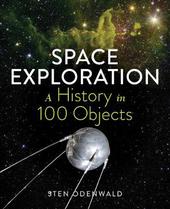
|
Space Exploration: A History in 100 Objects
Hardback
Main Details
| Title |
Space Exploration: A History in 100 Objects
|
| Authors and Contributors |
By (author) Sten Odenwald
|
| Physical Properties |
| Format:Hardback | | Pages:256 | | Dimensions(mm): Height 209,Width 249 |
|
| Category/Genre | Photographs: collections
Space science
Popular astronomy and space |
|---|
| ISBN/Barcode |
9781615196142
|
| Classifications | Dewey:629.4352 |
|---|
| Audience | |
|---|
|
Publishing Details |
| Publisher |
The Experiment LLC
|
| Imprint |
The Experiment LLC
|
| Publication Date |
1 November 2019 |
| Publication Country |
United States
|
Description
This eclectic pop history of space exploration, by scientist-educator Sten Odenwald at NASA, examines 100 objects - all stunningly photographed - and their effect on what we know and how we think about space. Whimsical and uniquely clarifying, SPACE EXPLORATION: A HISTORY IN 100 OBJECTS covers the iconic, from Sputnik to Skylab, as well as the lesser-known but utterly important: *The ancient Greek Antikythera mechanism, the first known analog computer, which predicted astronomical movement. *Luna 3, the first satellite to glimpse the far side of the moon. The O-ring; the humble, rubber part that doomed the Space Shuttle Challenger. *Syncom 2, the first geosynchronous satellite, which made international TV possible. *The V-2 rocket, the first artificial object to cross the threshold of space - and many more!
Author Biography
Dr. Sten Odenwald is an award-winning astrophysicist and prolific science popularizer, who has been involved with science education for the COBE, IMAGE, Hinode, and InSight missions, as well as NASA's Sun-Earth Connection Education Forum. He is currently the director of citizen science for the NASA Space Science Education Consortium at the NASA Goddard Space Flight Center and lives in Maryland.
ReviewsA Junior Library Guild Selection "Captivating . . . fun as well as informative, this lightweight encyclopedia of intriguing objects will fascinate readers of any age."--Publishers Weekly starred review "This engaging trek through the annals of human invention considers 100 physical artifacts that directly or indirectly advanced space exploration. . . . Whether read straight through or referenced by artifact, [Odenwald's] collection of brief but enlightening entries is addictive and should appeal to a wide audience. . . . This diverse assortment of STEM milestones provides science, technology, and space enthusiasts plenty to ponder - and even debate."--Booklist "Odenwald includes details about more familiar historical objects that may yet be unknown to many readers, but also includes essays about many less well known objects that reveal how much many traditional cultures knew about the Moon, planets, and stars."--Choice "Open to any page and find something fascinating to absorb--visually and intellectually."--David Latham, senior astronomer, Harvard-Smithsonian Center for Astrophysics "Space Exploration presents a fascinating and unusual new way of viewing more than 70,000 years of space history in 100 objects that each brought us one step forward in our understanding of the cosmos. The result is a new perspective of how the human race went from the first step in comprehending space to the first glimpse of a black hole. A most enjoyable and mind-changing book!"--Dr. Giovanni G. Fazio, senior physicist, Harvard-Smithsonian Center for Astrophysics "From ancient tablets to the Tesla roadster orbiting the Sun, from the earliest rockets to the rovers on Mars, this intriguing book traces humanity's involvement in space through the machines and equipment that made it possible. With the assurance of a veteran space author, Odenwald explains and illuminates the steps in our exploration of the realms beyond Earth."--Andrew Fraknoi, author of Voyages through the Universe "An insightful collection of human achievements. After reading this book, I am overwhelmed at how far we've come, from chipping figures on a piece of stone to sending a man to the moon to having a computer on my lap that allows me to get information about almost anything, including the first-ever image of a black hole taken this year."--Dr. Art Poland, affiliate professor, Department of Physics and Astronomy, George Mason University
|